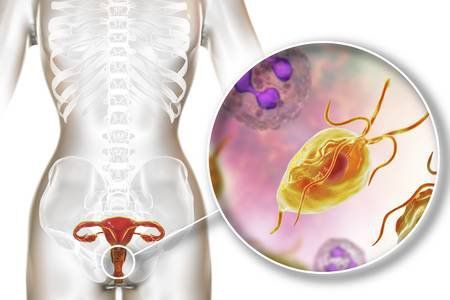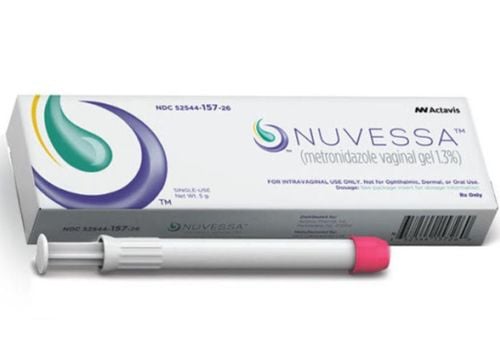This is an automatically translated article.
The article was professionally consulted with Specialist Doctor II Huynh Thi Hien - Department of Obstetrics and Gynecology - Vinmec Nha Trang International General Hospital.Vaginitis is not uncommon in women. The main cause of the disease is due to improper personal hygiene of the vaginal area or infection from a sexual partner. Although it is a fairly common disease, most women do not have much knowledge about the disease, are afraid and afraid to go to the doctor, leading to unfortunate complications.
1. What is vaginitis?
Vaginitis (or vaginal infection) is an infection in the vagina of women. Statistics show that up to one-third of women will experience symptoms of vaginitis in their lifetime. It can affect women of any age, but is most common in women of reproductive age.2. Causes of vaginitis
An imbalance in the yeast and bacteria living in the vagina is the cause of vaginitis. This condition causes the lining of the vagina to become inflamed. Specifically, the following factors can affect the inherent balance of the vagina, including:Use of antibiotics Changes in hormone levels during pregnancy, lactation or menopause Douching vagina Spermicide use Sexual activity Simple infection (most commonly yeast infection)
3. Diagnosis of vaginitis
To diagnose vaginitis, your doctor will remove a sample of discharge from your vagina and examine it under a microscope. In addition, other tests may be ordered to accurately determine the likelihood of a vaginal infection.4. Treatment of vaginitis
How to treat vaginitis will depend on the cause of the vaginitis. Treatment can be done in the form of pills, creams or gels applied to the vagina. There are the following common causative agents of vaginitis:Yeasts Trichomonas bacteria Each type of agent will have different mechanisms of disease, symptoms and treatment. We invite you to read on to learn more about each of the above actors through the topics below.
5. Vaginitis caused by yeast
5.1. Mechanism of yeast vaginitis
Yeast, also known as Candida, is the most common cause of vaginal infections.Candida is found in relatively small amounts in the normal vagina of a woman. However, when the balance of bacteria and yeast in the vagina is altered, this type of yeast has the potential to overgrow and cause vaginal symptoms. This condition is also called a yeast infection.
5.2. What factors increase your risk of getting a yeast infection?
Using certain antibiotics increases the risk of yeast infections, which in turn cause vaginitis. This is because antibiotics usually kill bacteria, but they also affect the normal bacteria in the vagina, causing a loss of yeast control.Yeast then has the ability to overgrow without the restriction of bacteria. Women are more likely to get a yeast infection if they are pregnant or have diabetes. Yeast overgrowth is also more common if the body's immune system is malfunctioning and not working as well.
5.3. Symptoms of a yeast infection

5.4. Treatment of vaginitis caused by yeast infection
Yeast infections can be treated with vaginal (locally acting) or oral (systemic) medications. In addition, over-the-counter treatments are considered safe and often effective in treating vaginitis caused by yeast infections. However, many women actually have another problem, but think they have a yeast infection and buy medicine to treat it themselves. In this case, medications for yeast infection will not be able to correct the symptoms and may lead to a delay in the correct diagnosis and proper treatment of the disease.Even if you have had a yeast infection before, you should go to the hospital to see an obstetrician and gynecologist. Because there have been many cases of using over-the-counter drugs for a long time, but the symptoms of vaginitis still do not go away.
6. Bacterial vaginosis
6.1. Mechanism of bacterial inflammation
Bacterial overgrowth due to various causes can lead to vaginitis.6.2. Signs of bacterial vaginosis
The main sign is increased vaginal discharge, accompanied by a fishy odor. The discharge is usually thin, dark or dull gray in color, but may be green in color. Bacterial vaginosis rarely causes itching, but can occur if the discharge is excessive.6.3. How to cure bacterial vaginosis
Several antibiotics are used to treat bacterial vaginosis. Regarding the route of use, it can be taken orally, or vaginally in the form of a cream or gel.7. Vaginitis caused by Trichomonas
7.1. Inflammatory mechanism of Trichomonas

7.2. Symptoms caused by Trichomonas
Symptoms of Trichomonas infection typically include: Vaginal discharge that is yellow-gray or green and may have a fishy odor. The patient's vulva is burning, irritated, and causes redness and swelling. Sometimes the patient feels pain while urinating.7.3. Treatment of vaginitis caused by Trichomonas
Trichomonas can be eradicated with a single dose of oral antibiotics. Note that your sexual partner must also be treated to prevent the infection from recurring.8. Atrophic vaginitis in lactating women and menopause
Atrophic vaginitis is not caused by an infection but can also cause discharge and irritation of the vagina, such as dryness, itching, and burning. This condition can occur at any time when female hormone levels are low, such as during breastfeeding and after menopause. Atrophic vaginitis is treated with estrogen. Using a liquid lubricant is also an effective way to limit symptoms of atrophic vaginitis during sex.Basic gynecological examination and screening package at Vinmec International General Hospital for customers with abnormal symptoms such as: Abnormal vaginal bleeding; Menstrual problems; Abnormal vaginal discharge (with a bad smell, a different color than usual); Vaginal pain and itching....Female customers have several risk factors such as poor personal hygiene, unsafe sex, abortion, ..Female customers have other symptoms of infection ...
When registering for the basic gynecological examination and screening package at Vinmec, you can perform ultrasound techniques and examination to detect inflammatory diseases early for easy treatment, without costly; Screening for early detection of gynecological cancer.
Please dial HOTLINE for more information or register for an appointment HERE. Download MyVinmec app to make appointments faster and to manage your bookings easily.
Reference source: Acog.org













